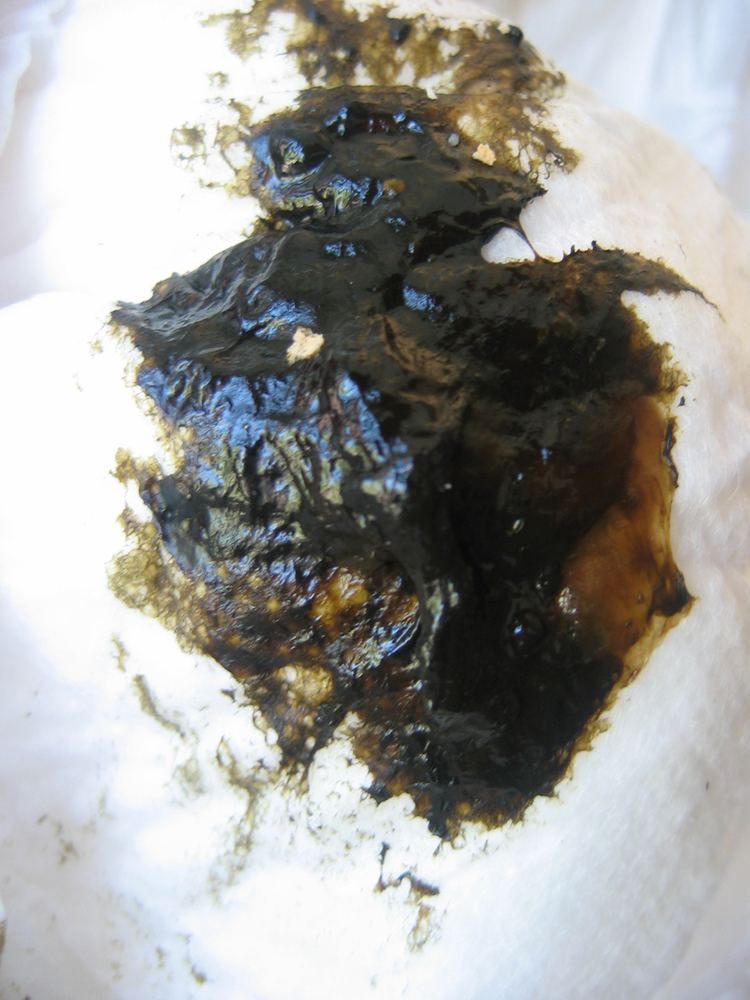 | ||
Meconium is the earliest stool of a mammalian infant. Unlike later feces, meconium is composed of materials ingested during the time the infant spends in the uterus: intestinal epithelial cells, lanugo, mucus, amniotic fluid, bile, and water. Meconium, unlike later feces, is viscous and sticky like tar, its color usually being a very dark olive green; it is almost odorless. When diluted in amniotic fluid, it may appear in various shades of green, brown, or yellow. It should be completely passed by the end of the first few days after birth, with the stools progressing toward yellow (digested milk).
Contents
Meconium is normally retained in the infant's bowel until after birth, but sometimes it is expelled into the amniotic fluid (also called "amniotic liquor") prior to birth or during labor and delivery. The stained amniotic fluid (called "meconium liquor" or "meconium stained liquor") is recognised by medical staff that this may be a sign of fetal distress. Some post-dates pregnancies (where the woman is more than 40 weeks pregnant) may also have meconium stained liquor without fetal distress. Medical staff may aspirate the meconium from the nose and mouth of a newborn immediately after delivery in the event the baby shows signs of respiratory distress to decrease the risk of meconium aspiration syndrome.
Meconium had been thought to be sterile until the team of researchers from the University of Valencia in Spain found bacterial communities in it so developed that they seemed to fall into two categories. Around half of the samples appeared to be dominated by bacteria that produce lactic acid, such as lactobacillus, while the other half mostly contained a family of so-called enteric bacteria, such as Escherichia coli.
The Latin term meconium derives from the Greek μηκώνιον, mēkōnion, a diminutive of μήκων, mēkōn, i.e. poppy, in reference either to its tarry appearance that may resemble some raw opium preparations, or to Aristotle's belief that it induces sleep in the fetus.
A symptom of both Hirschsprung's disease and cystic fibrosis is the failure to pass meconium.
Meconium can be tested for various drugs, to check for in utero exposure. Using meconium, a Canadian research group at the Hospital for Sick Children, University of Toronto, showed that by measuring a by-product of alcohol (FAEE) they could objectively detect babies exposed to excessive maternal drinking of alcohol in pregnancy. In the USA, the results of meconium testing may be used by child protective services and other law enforcement agencies to determine the eligibility of the parents to keep the newborn.
Terminal meconium
Most of the time that the amniotic fluid is stained with meconium it will be homogeneously distributed throughout the fluid making it brown. This indicates that the fetus passed the meconium some time ago such that sufficient mixing occurred as to establish the homogeneous mixture. Terminal meconium occurs when the fetus passes the meconium a short enough time before birth/caesarean section that the amniotic fluid remains clear, but individual clumps of meconium are in the fluid.
Meconium ileus
The meconium sometimes becomes thickened and congested in the intestines, a condition known as meconium ileus. Meconium ileus is often the first sign of cystic fibrosis. In cystic fibrosis, the meconium can form a bituminous black-green mechanical obstruction in a segment of the ileum. Beyond this there may be a few separate grey-white globular pellets. Below this level, the bowel is a narrow and empty micro-colon. Above the level of the obstruction, there are several loops of hypertrophied bowel distended with fluid. No meconium is passed, and abdominal distension and vomiting appear soon after birth. About 20% of cases of cystic fibrosis present with meconium ileus, while approximately 20% of one series of cases of meconium ileus did not have cystic fibrosis. The presence of meconium ileus is not related to the severity of the cystic fibrosis. The obstruction can be relieved in a number of different ways.
Meconium ileus should be distinguished from meconium plug syndrome, in which a tenacious mass of mucus prevents the meconium from passing and there is no risk of intestinal perforation. Meconium ileus has a significant risk of intestinal perforation. In barium enema, meconium plug syndrome rather shows normal or dilated colon as compared to micro-colon in meconium ileus.
